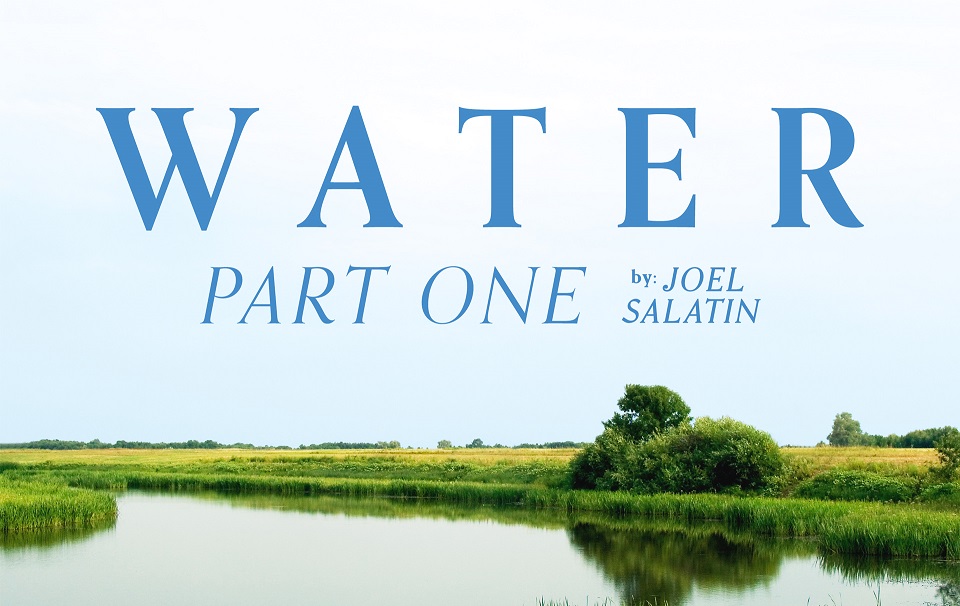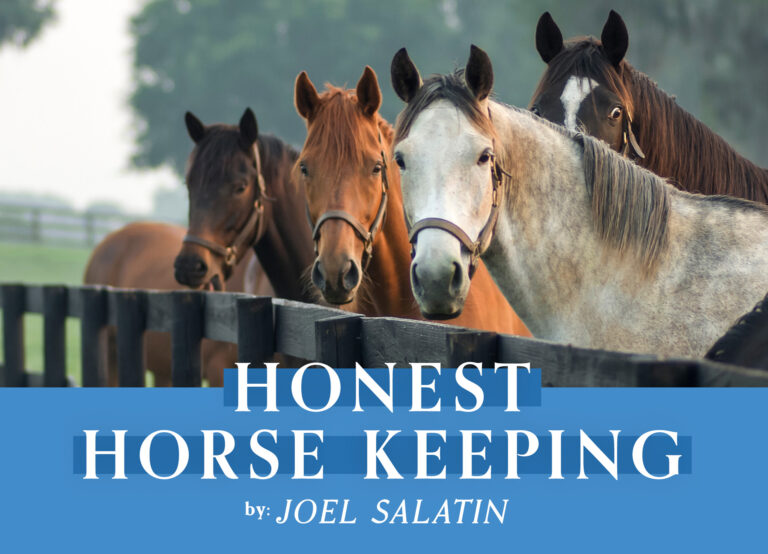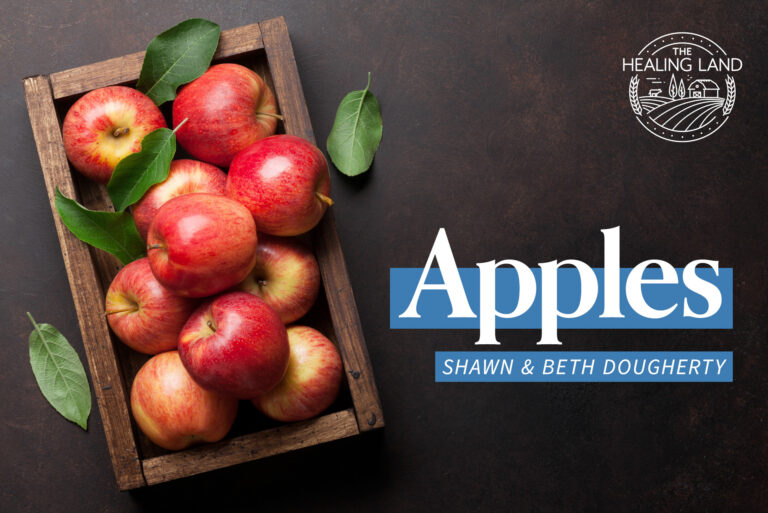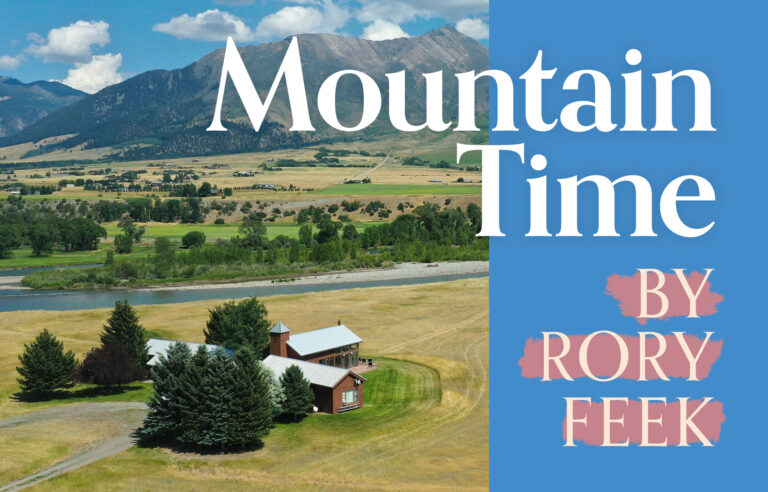By Joel Salatin, Plain Values
Water is the prerequisite to life. Some living things don’t need sunlight, some don’t even need soil, but all living things need water. Certainly, when we think about water, the first source that comes to mind is rain. But rain is not consistent, and most plants need water routinely. Indeed, some plants need more water than others, but scarcity is often the limiting factor in farm and garden production.
As inconsistent as rain may be, global agricultural soil depletion in both quantity and quality has created a consistent loss, called surface runoff. Even the driest places on the planet have occasional downpours that, if left long enough, create floods. Most of us have lived through a few floods in our lifetime.
By definition, a flood is caused by too much surface runoff. In perfect conditions, raindrops fall on the earth and percolate into the soil. But if they fall faster than the soil can absorb them or in more volume than the soil can hold, they go somewhere besides down into the soil. That somewhere is running across the top of the soil. Due to soil degradation, primarily through mining out organic matter with tillage, chemicals, and overgrazing, the soils on the planet are not nearly as absorptive as they were centuries ago.
In fact, the rule of thumb today is that a third of all raindrops that fall on the earth cannot find a home where they fall. The soil either can’t absorb them fast enough, or the soil can’t hold any more. So whether the area is Nevada or Pennsylvania, one-third of the rain that falls becomes surface runoff. That is a big deal because it adds up fast.
One acre-inch of water—the amount of water that covers one acre one inch deep—is almost 30,000 gallons. Most non-irrigated agriculturally productive areas of the U.S. receive at least 30 inches of rainfall a year. Lancaster County, PA, receives a bit more than 50. Virtually everywhere east of the Mississippi receives more than 30 inches of rainfall a year. Applying our one-third rule, that means all of these acres lose 10 acre-inches of water a year.
Ten acre-inches of water is nearly 300,000 gallons per acre. That means if you have a 50-acre farm, chances are you’re losing 15,000,000 (that’s 15 million) gallons of water per year. If you have a small place, maybe 5 acres, you’re losing 1.5 million gallons a year; still no small amount. P.A. Yeomans wrote the iconic book Water for Every Farm back in the 1950s and challenged farmers and ranchers worldwide with two goals. First, we should aspire to never lose a drop of rain to surface runoff. Second, we should never end a drought with a full pond.
Water is perhaps the most visible and practical application of the notion that we, as caretakers of the earth, should build forgiveness into the landscape. Floods and droughts have been a part of the earth since the dawn of creation. Nobody will design a food or fiber production system immune to natural water events. As stewards, then, one of our objectives should be to extend forgiveness into the landscape like it’s been extended in our hearts. We need forgiveness for the sins of life like the landscape needs forgiveness for the storms of nature.
Most farmers talk about water like it’s some sort of esoteric thing over which they have no control. But water is highly tangible, measurable, and controllable. A key permaculture concept is that all raindrops should be held as close to where they fall for as long as possible. That means raindrops that fall on a ridge should be held on a ridge. Raindrops that fall on a hill should be held on a hill, or as close to it as possible. In general, our holding capacity should be as high on the landscape as possible.
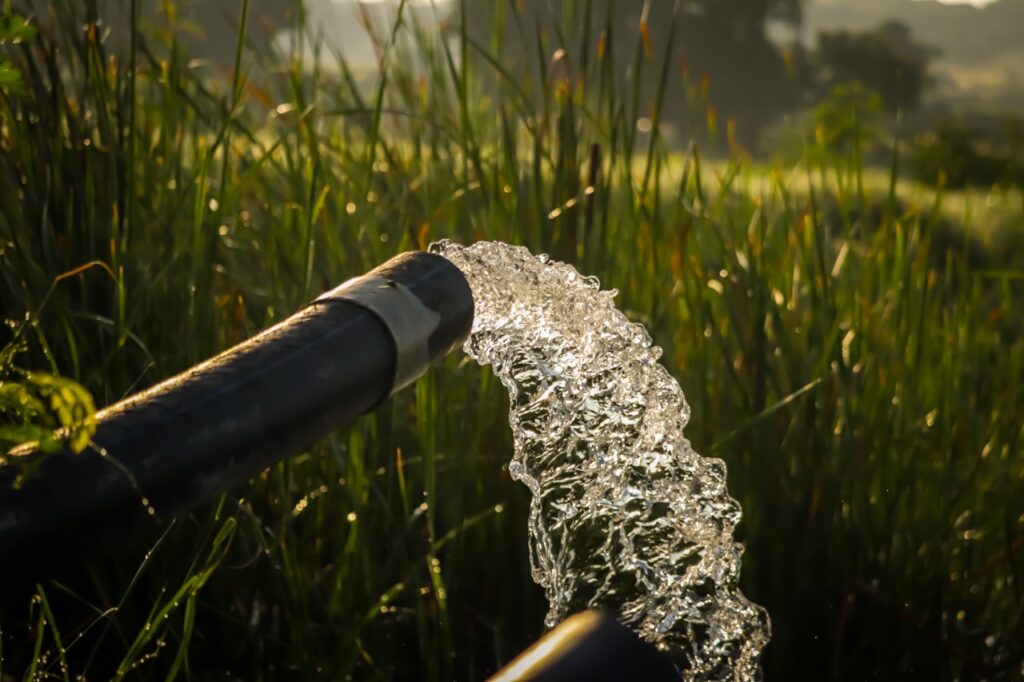
The higher our water storage is on the terrain, the more options we have to use those gallons on their gravitational journey downhill. Some people think landscaped ponds or even water barrels are akin to selfishness or hoarding, depriving people downstream of water that’s rightfully theirs. But Yeomans argued that surface runoff, by definition, means that the commons is full. The commons is shared water that you can’t create. Aquifers, springs, and streams are all part of the commons.
One of my benchmarks of truth is that if everyone can’t do it, then it’s probably not a good practice. In this instance, if everyone puts a straw in a river or an aquifer and starts sucking out water, at some point, you don’t have an aquifer or river. The Colorado River is a prime example of a river that is virtually depleted by the time it gets to the ocean. Everyone wants a piece of it; that’s depleting the commons.
Part of our human mandate as stewards is to increase the commons. In other words, where at one time X water flowed, our goal should be 2X. That’s returning more talents than we’re given; it’s giving God a Return on Investment (ROI) in business terms. Few things illustrate redemption extension better than increasing the hydrology of a landscape. Historically, when people talked about getting water, they dug wells.
Fortunately, water that slowly percolates through the soil and into the aquifer encounters all sorts of purifying agents as it goes, generally yielding potable water from a well. Unfortunately, modern chemicals and heavy concentrations of manure have rendered many wells undrinkable, but in virtually any primitive place on the planet, aquifer water is potable. For irrigation and general use purposes, however, aquifer water is neither the healthiest nor the ecologically best due to depletion of the commons. Plants like living water from ponds and open sources, not sterile, highly mineralized water from aquifers.
One of the first goals, then, of any farming operation should be to eliminate surface runoff and to use those stored raindrops strategically, either to water animals or crops. When we impound surface runoff, we do not steal resources from downhill neighbors. Instead, we protect them from flooding. And if we use these raindrops during droughts, we bless our neighbors with vegetative growth and base flow—not all the irrigation water gets uptaken by plants. Much of it percolates into the soil, just like rain.
As long as they catch only surface runoff, ponds bless our neighbors in both flood times and drought times. The distinction between surface runoff and the commons is critical because one is fairly fixed, and the other can be dramatically enhanced. The surface runoff that creates flood damage can be harnessed in ponds to bless an entire landscape with water during a drought. Here where I live in Virginia’s Shenandoah Valley, if all the soil that’s been moved to grow unneeded corn for herbivores who shouldn’t eat it anyway, had been moved judiciously in valleys to create ponds, today this whole region would be virtually floodproof and drought-proof. How does that sound for a redemptive landscape policy?
The tragedy of the human experience is not that we’re lazy. It’s that we’re successful at the wrong things. Ranching for Profit founder Stan Parsons used to say, “We’ve become adept at hitting the bullseye of the wrong target.” Indeed, we’ve learned how to deplete the commons by pumping water out of the aquifers, but we haven’t been successful at hitting the proper objective, which is how to hold surface runoff for future blessing.
Louis Bromfield, certainly the most famous farmer in America in the 1940s and 1950s, said the answer to flooding on the Mississippi River was not massive Army Corps of Engineers projects on the big river because, by that time, the volume and velocity of the water were too much for manmade control. He envisioned millions of small farm ponds dotting the Mississippi watershed, all holding their million gallons like giant hoof prints on the landscape. That water, held high on the landscape, could be dispensed strategically on parched and thirsty soil.
“The thing I want to emphasize is that when we say ‘get water,’ at least for agricultural use,
a well should be the last resort.”
Archaeologists now say that 500 years ago, North America was more than 8 percent water; today, it’s less than 4 percent. Much of that water was beaver ponds, built by 200 million hardworking beavers, some dams the size of a Volkswagen automobile. Not only have we destroyed the beavers; we’ve disrespected their humble pursuit and depleted the protective hydrologic labyrinth. As land stewards, certainly one of our most important and fundamental mandates is to restore this hydrologic abundance to the landscape.
I’ll write a lot more about water in future columns, but for now, the thing I want to emphasize is that when we say “get water,” at least for agricultural use, a well should be the last resort. In conventional thinking, a well is the first resort. But a well can never increase the commons. It’s a straw stuck into the commons glass, if you will, that inevitably depletes the shared resource. A pond holding back surface runoff takes water that overruns the commons cup and saves it for a drier day. It increases the commons in a practical and significant way.
On our farm, we’ve built some 15 ponds over the years. Every time we get a few extra dollars, we build another pond. Now, routinely, when the rivers flood, our ponds fill gradually. Few things please me more than checking on the ponds in a flood and watching them filling, but not yet full. And few things please me more than seeing all that water stored in a drought. That’s true wealth and true stewardship.
This article was published in the May 2022 issue of Plain Values Magazine. If you want the latest stories every month, subscribe to the magazine HERE. As a special thanks, get 10% off your subscription with the code “GAB23”!

Joel co-owns, with his family, Polyface Farm in Swoope, Virginia. When he’s not on the road speaking, he’s at home on the farm, keeping the callouses on his hands and dirt under his fingernails, mentoring young people, inspiring visitors, and promoting local, regenerative food and farming systems


